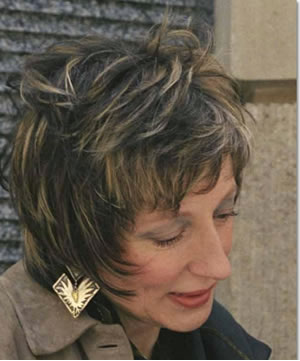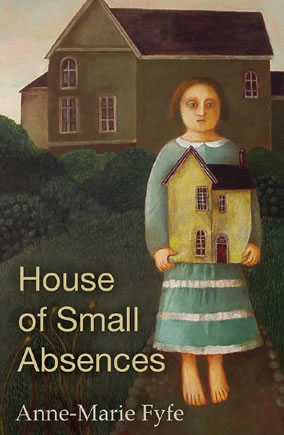'The Spaces We Inhabit'
Local poet Anne Marie Fyfe tells of how a sense of places inspired her latest collection
|
Chiswick resident, Anne-Marie Fyfe’s fifth poetry collection, House of Small Absences (Seren Books) has recently been published.
Born in Cushendall, Co. Antrim, Anne-Marie works as an arts organiser. She has won the Academi Cardiff International Poetry Prize, has run Coffee-House Poetry’s readings & classes at London’s leading live literature venue, the Troubadour since 1997, is Poetry Co-ordinator for the annual John Hewitt International Summer School in Armagh City, & is a former Chair of the Poetry Society.

Image by Anna Mc Carthy
Anne-Marie Fyfe’s poems have long dwelt on the role that the spaces we inhabit, the places in which we find security, play in our lives: House of Small Absences is an observation window into strange, unsettling spaces—a deserted stage-set, our own personalised ‘museum’, a Piedmont albergo, underground cities, Midtown roof-gardens, convent orchards, houseboats, a foldaway circus, a Romanian sleeper-carriage—the familiar rendered uncanny through the distorting lenses of distance and life’s exigencies, its inevitable lettings-go.
Writer Helen Dunmore comments that:"Anne-Marie Fyfe’s poetry is taut, eloquent and deeply felt. Her poems are haunted by what the past does to the present, and by the physical relics of that past which is only relayed in snatches.” Poet Tom Paulin says they have " a lyric clarity, an ontological accuracy and unflinching vigilance that is both spiritual and revelatory.”
Annemarie answered some questions just before heading to Ireland for the annual John Hewitt Summer School
You’ve worked in London for many years as an arts-organiser and creative-writing teacher: but are the poems mostly about London or Cushendall where you grew up?
Some poems aren’t about any specific place of course, but the poems in my latest collection have elements of both, of home in London and ‘home’ in Ireland. But New York features too, as I spend every spring in the US, sometimes on reading tours, sometimes simply staying in Manhattan, going to galleries, and plays, and simply writing.
Have you written much about New York?
I think New York’s a city we all feel we know and there were poems in my first book based on visits there years ago, but more recently I spent a month at Ground Zero in Lower Manhattan, where the new buildings were going up to replace the Twin Towers and some poems came out of not just that, but all of New York’s fascinating history.
Have you read those poems there? How do American audiences react?
When the new book came out I was asked to read at St. Paul’s Chapel, the oldest church in Manhattan and – because it’s right opposite Ground Zero – the railings where all those ‘missing’ notices went up, a place of refuge and recuperation for the hundreds of firefighters, and the rescue workers who were around that site for months afterwards, and now a place of badges and flags and rememberances of lost ones and memories of a city’s solidarity. It was a great honour to read there and to have New Yorkers come and talk to me about the poems and about that time.
So does being ‘at home’ feature at all?
The various Chiswick houses we’ve lived in, and loved or not loved, have been a consistent theme throughout my poetry life. Including the house we nearly bought that I still see from the platform at Turnham Green Station, including the house-with-a-backstory that never grew to love us, including the house we love (which we live in now), the house where we brought up our children but - in one poem - I’m imagining it years later with someone else living there, or maybe only the ghosts of our past lives.
The critic Ian Gregson has talked about how some of my poems dwell in the world of the uncanny, the unfamiliar, or rather the familiar that suddenly becomes unfamiliar. So a number of the poems in the current collection are strange memories of those London houses, and of houses from childhood, great stark houses on headlands, a house in an Edwardian terrace in a seaside town with some strange inhabitants, a houseboat, a garden shed, an attic... all those spaces one inhabits over time.

Some of that is signalled by the cover picture, ‘A House for Me’ by painter Nicola Slattery.
One of the things I’ve been balancing for years is this idea of slightly surreal places, museums, cinemas, institutions, and the simpler poems, of home, of schooldays, of the limits of one’s childhood universe…
And I already have a strangely surreal but touching painting by Nicola Slattery of a woman, a fish and a boat (bought in a gallery in Chiswick). So when I saw this picture—in a gallery in Central London - by someone who was already a favourite artist, of a woman walking away from a slightly forbidding house, but carrying a dolls-house with her – and one of my ideas of returning home is that one’s ‘dolls’-house is still in the attic’ – she seemed to have captured the same notion about the houses we carry with us. But is she leaving home? Is it that home will never leave her? Is it about possession or flight?
‘Flight’ in another sense is a recurring theme, can you tell me about that?
One of the more significant poems in one of my earlier collections had a line ‘A plane flies off a map’s edge today…’ which was my instant reaction to 9/11 (& was the poem which won the Cardiff International prize). I know the world of flight has been altered for everyone since that terrible day, but I’d grown up in an atmosphere of fascination with flight partly because my father had wanted to be a pilot but had no way to achieve that ambition: the closest he got was working on US Air Force planes in the North of Ireland during the war. But the fascination stayed with him and I remember his reading every snippet about Amelia Earhart’s disappearance and clues that turned up in the 1950s and 60s, so one poem conjures up that fascination.
How do you fit in your writing with the world of arts-organising?
One of the great things about being a writer is that you’re constantly invited to read and talk about your poems, here in Britain, in Ireland, in Europe and in the US. Which means you’re often on reading bills and at literature festivals with other poets and writers who are constantly talking about the art and the imagination and reading their own work.
On top of that I get to a lot of theatre and art here in London, in New York and elsewhere. So there are always more ideas, more new directions than you can fully develop when you’re also organising the year-round Troubadour reading series, and an annual Literary Festival in Ireland, and residential courses in France, and lots of once-a-year events like the Bedford Park poetry evenings.
So the secret is to get away every now and again, Belfast, New York, or Cushendall, and, once you’ve caught up with friends and family, lock yourself away and live like a hermit for a few weeks. And suddenly all those ideas that have been swirling around in your head start becoming poems, a long slow process... "
Anne-Marie is married to writer, musician and broadcaster Cahal Dallat and they recently organised a very succesful Poetry Evening to celebrate the 150th anniversary of the birth of W. B. Yeats at St Michael & All Angels Church, as part of the Bedford Park Festival.
You can order House of Small Absences here
Anne Marie will be hosting readings from Mon 19 Oct—Mon 14 Dec, 8 pm fortnightly, Autumn 2015 Coffee-House Poetry at the Troubadour, Earls Court.
www.annemariefyfe.com
www.coffeehousepoetry.org
www.serenbooks.com/productdisplay/house-small-absences
July 10, 2015